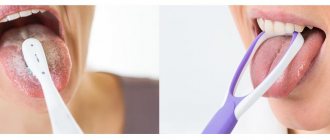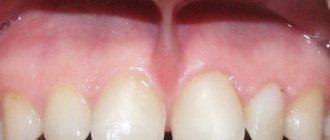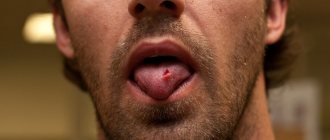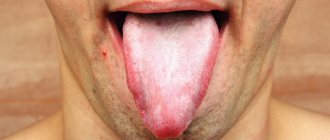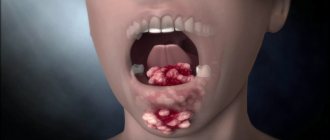The bridle is a film. The tongue is attached by this film to the lower jaw, to the oral cavity. The normal length of the frenulum is 1.5 centimeters. If it is smaller than usual, then the movements of the tongue are limited. It happens that it is shorter than usual or is in the wrong place. All this interferes with speaking correctly. And people with such problems wonder how to fix it so as not to cause themselves pain. If infants have such a pathology, then this prevents them from latching onto the breast correctly. But how to lengthen your tongue? The methods below will help you make your tongue longer.
Signs of an abnormal (shortened) frenulum
A normal frenulum of the tongue in a newborn should be about 8 mm long. By the age of five, its length can increase to 17-18 mm.
Signs of a lack of frenulum length in infants:
- feeding lasts longer than usual and occurs with short stops;
- the baby is capricious when feeding;
- the child arches, throws back his head;
- underweight;
- the baby bites the breast and “clicks” when feeding;
- The baby may refuse to breastfeed.
Signs of a short frenulum of the tongue in older children and adult patients:
- malocclusion;
- frequently recurring periodontitis;
- problematic fixation of prostheses;
- difficulties in pronouncing many sounds;
- periodontal diseases.
A shortened frenulum is also indicated by:
- lower incisors directed inward;
- bifurcation of the tip of the tongue and its deepening when trying to stretch it;
- inability to reach the tip of the tongue to the sky or lick your lips;
- the tongue is uneven, its lower end is pressed, and its rear end is raised;
- have difficulty swallowing solid food;
- heart-shaped tongue in an elevated position;
- the tongue bends as it moves forward.
If a shortened frenulum of the tongue is detected, its correction is required. And the sooner this is done, the better.
There are different types of tongue frenulum anomalies:
- thin transparent (because of it the tongue functions poorly, but the child does not feel discomfort);
- translucent, with a bifurcating ending when the tongue moves;
- thick, attached to the lower palate and noticeably limiting its mobility;
- short, fused with the muscles of the tongue;
- unexpressed, difficult to notice due to complete fusion with the muscles (the tongue moves with difficulty, swallowing food is difficult and speech disorders are observed).
In each case, the doctor determines the degree of shortening of the frenulum and the method of treating the anomaly.
Hidden sources of psychosomatics of language in the studies of famous adherents of metaphysics.
Louise Hay sees the reasons contributing to the emergence of language pathologies in such emotions and mental trauma, and recommends repeated repetition of affirmations to combat them (see table):
| Disease | Possible reasons | Positive Affirmations |
| Language | Symbolizes the ability to joyfully taste the pleasures of life. | I rejoice in the great bounty of my life. |
| Mouth diseases | Bias. Closed mind. Inability to perceive new thoughts. | I welcome new ideas and new concepts. I'm ready to learn them. |
| Pip on the tongue, psychosomatics of wounds in the oral cavity | Poisonous words held back by lips. | I create only joyful events in a loving world. |
| Candidiasis. | Feeling scattered. Intense frustration and anger. Claims and distrust of people. | I allow myself to be who I want. I deserve the best in life. I love and value myself and others. |
Popular researcher Liz Burbo points out the most common pathologies of the tongue: ulcers, cancer, damage, tumors, numbness, burns, biting. From the author's point of view, the main problems with language indicate to the patient his feeling of guilt about eating or saying something unnecessary. So, if the victim bit his tongue, the psychosomatics of the injury indicates a feeling of guilt about what was said or planned.
Given that the tongue performs various functions, Liz Burbo recommends using additional questions to accurately determine what the patient feels guilty about. She recommends that the victim not blame himself for his love of food and realize that any pain in the tongue indicates his incorrect perception of good and evil. The researcher advises him to try to express himself and develop unconditional love.
The famous doctor Luule Viilma believes that problems with language, based on the psychosomatics of diseases, have the following sources (see table):
| Ailments | Mental trauma | Book | Page no. |
| Tongue cancer | The shame of having ruined my life with my own tongue. | “Forgiveness, real and imaginary” | 185 |
| Loss of taste in children. | Parents censure the child’s sense of beauty, declaring him devoid of a sense of taste, tasteless. | “Forgiveness, real and imaginary” | 184 |
| Aphthous stomatitis. | Blaming yourself, regretting your behavior. | "Pain in Your Heart" | 222-224 |
| Ulcers of any kind, including pip on the tongue, psychosomatics of the disease. | Suppressing the sadness that comes from not wanting to be helpless and show your helplessness. | "Pain in Your Heart" | 156 |
The creator of the “New German Medicine”, Dr. R.G. Hamer explains the metaphysics of language pathologies with various personal conflicts that grip the victim when a Special Biological Program of the superficial mucous membrane of the lips and mouth arises:
- Complete or partial paralysis of the tongue, psychosomatics with a motor conflict - I can’t, don’t want, or I can’t say something, regret about what was said;
- Inflamed mucous membrane of the tongue during scarlet fever in the healing phase of the separation conflict during the restoration of squamous epithelium;
- Painful point erosions, ulcerations of the oral mucosa in the conflict of separation regarding the lips, mouth or tongue: to be separated or, conversely, the desire to separate, to separate; not being able or willing to say something; regret what was said; want or, conversely, not want contact; regarding food or diet instructions.
Indications for surgery
Abnormal frenulum length is corrected surgically. Surgery at an early age is indicated in the following cases:
- when the baby has difficulty sucking the breast;
- when a child begins to develop an abnormal bite;
- when a displacement of the dentition occurs in the baby’s oral cavity;
- even if the speech therapist cannot help the child correct speech defects.
Up to a year, the frenulum is cut with scissors and stitches are applied if necessary. The operation is performed quickly and painlessly, since there are no nerve endings in the frenulum.
Preschoolers and children of primary school age also have their frenulum cut, but a little differently. The frenulum is cut with a special scalpel, and the attachment site is moved to another place and sutures are applied.
Teenagers' bridles are not cut. A speech therapist works with them, and the dentist prescribes special exercises to stretch the frenulum.
Correction of the frenulum can also be indicated for patients in adulthood (at one of the stages of orthopedic treatment).
how to stretch the frenulum of the tongue
Lip exercises
1. Smile.
Keeping your lips in a smile.
The teeth are not visible. 2. Proboscis (Tube).
Pulling the lips forward with a long tube.
3. Fence.
The lips are in a smile, the teeth are closed in a natural bite and are visible.
4. Bagel (Speaker).
The teeth are closed.
The lips are rounded and slightly extended forward. The upper and lower incisors are visible. 5. Fence - Bagel.
Smile - Proboscis. Alternating lip positions.
6. Rabbit.
The teeth are closed. The upper lip is raised and exposes the upper incisors.
Exercises to develop lip mobility
1. Biting and scratching first the upper and then the lower lip with your teeth. 2. Smile - Tube.
Pull your lips forward with a tube, then stretch your lips into a smile.
3. Piglet.
Move your lips extended like a tube left and right, and rotate them in a circle.
4. The fish talk.
Clap your lips together (make a dull sound).
5. Squeeze the upper lip by the nasolabial fold with the thumb and index fingers of one hand and the lower lip with two fingers of the other hand and stretch them up and down. 6. Pull your cheeks firmly inward, and then sharply open your mouth. It is necessary to ensure that when performing this exercise, the characteristic sound of a “kiss” is heard. 7. Duck.
Stretch your lips, squeeze them so that your thumbs are under the lower lip, and all the rest are on the upper lip, and pull your lips forward as much as possible, massaging them and trying to imitate the beak of a duck.
8. Dissatisfied horse.
The flow of exhaled air is easily and actively sent to the lips until they begin to vibrate.
The result is a sound similar to the snorting of a horse. 9. The mouth is wide open, the lips are drawn inside the mouth, pressing tightly against the teeth. If the lips are very weak:
- puff out your cheeks strongly, holding the air in your mouth with all your might, - hold a pencil (plastic tube) with your lips, draw a circle (square), - hold a gauze napkin with your lips - the adult tries to pull it out.
Exercises for lips and cheeks
1. Biting, patting and rubbing cheeks.
2. Well-fed hamster.
Inflate both cheeks, then inflate the cheeks alternately.
3. Hungry hamster.
Pull in your cheeks. 4. Mouth closed. Hitting the puffed-out cheeks with your fist, causing the air to come out with force and noise.
Static exercises for the tongue
1. Chicks.
The mouth is wide open, the tongue lies quietly in the oral cavity.
2. Spatula.
The mouth is open, a wide, relaxed tongue rests on the lower lip.
3. Calyx.
The mouth is wide open.
The anterior and lateral edges of the wide tongue are raised, but do not touch the teeth. 4. Needle (Arrow. Sting).
The mouth is open.
The narrow, tense tongue is pushed forward. 5. Gorka (Pussy is angry).
The mouth is open.
The tip of the tongue rests on the lower incisors, the back of the tongue is raised up. 6. Tube.
The mouth is open.
The lateral edges of the tongue are curved upward. 7. Fungus.
The mouth is open. Suck your tongue to the roof of your mouth.
Dynamic exercises for the tongue.
1. Clock (Pendulum).
The mouth is slightly open.
The lips are stretched into a smile. With the tip of the narrow tongue, alternately reach at the teacher’s count to the corners of the mouth. 2. Snake.
The mouth is wide open.
Push the narrow tongue forward and move it deep into the mouth. 3. Swing.
The mouth is open.
With a tense tongue, reach for the nose and chin, or the upper and lower incisors. 4. Football (Hide the candy).
Mouth closed.
With a tense tongue, rest on one or the other cheek. 5. Brushing your teeth.
Mouth closed.
Move your tongue in a circular motion between your lips and teeth. 6. Coil.
The mouth is open.
The tip of the tongue rests on the lower incisors, the lateral edges are pressed against the upper molars. The wide tongue rolls forward and retracts into the depths of the mouth. 7. Horse.
Suck your tongue to the roof of your mouth and click your tongue.
Click slowly and firmly, pulling the hyoid ligament. 8. Accordion.
The mouth is open.
Suck your tongue to the roof of your mouth. Without lifting your tongue from the roof of your mouth, strongly pull down your lower jaw. 9. Painter.
The mouth is open.
Using the wide tip of the tongue, like a brush, we move from the upper incisors to the soft palate. 10. Delicious jam.
The mouth is open.
Using a wide tongue, lick your upper lip and move your tongue deep into your mouth. 11. Let's lick our lips.
The mouth is slightly open. Lick first the upper, then the lower lip in a circle.
Exercises to develop mobility of the lower jaw
1. Cowardly little bird.
Open and close your mouth wide, so that the corners of your lips extend.
The jaw drops approximately the width of two fingers. The “chick” tongue sits in the nest and does not protrude. The exercise is performed rhythmically. 2. Sharks.
On the count of “one” the jaw lowers, on “two” - the jaw moves to the right (mouth open), on the count of “three” - the jaw is lowered into place, on “four” - the jaw moves to the left, on “five” - the jaw is lowered, on “six” - the jaw moves forward, “seven” - the chin is in its usual comfortable position, the lips are closed.
You need to do the exercise slowly and carefully, avoiding sudden movements. 3. Imitation of chewing with a closed and open mouth. 4. Monkey.
The jaw drops down with the tongue extending to the chin as much as possible.
5. Angry lion.
The jaw drops down with the maximum extension of the tongue towards the chin and the mental pronunciation of the sounds a or e on a firm attack, more difficult - with a whispered pronunciation of these sounds.
6. Strongman.
The mouth is open.
Imagine that there is a weight hanging on your chin that needs to be lifted up, while raising your chin and straining the muscles underneath it. Gradually close your mouth. Relax. 7. Place your hands on the table, fold your palms one on top of the other, rest your chin on your palms. Opening your mouth, press your chin onto your resisting palms. Relax. 8. Lower the jaw down while overcoming resistance (the adult holds his hand under the child’s jaw). 9. Open the mouth with the head tilted back, overcoming the resistance of the adult’s hand lying on the back of the child’s head. 10. Teasing.
Open your mouth wide and often and say: pa-pa-pa. 11. Silently, lingeringly (on one exhalation), say vowels: aaaaaaaaaaaaaaaaaaaaaaaaaaaaaaaaaaayayayayayayayayayayayayayayayaya (the distance between the teeth in two fingers); ooooooooooooooooooooooooooooooooooooooo (the distance between the teeth is one finger); iiiiiiiiiiii (mouth slightly open). 12. Pronounce vowel sounds with your voice: aaaaaaaaaaaaa yaaaaaaaaaaaaaaaaaaaaaaaaaaaaaaaaaaaaaaaaaaaaaaaaaaaaaaaaaaaaaaaaaaaaaaaaaaaaaaaaaaaaaaaaaaaaaaaaaaaaaaaaaaaaaaaaaaaaaaaaaaaaaaaaaaaaaaaaaaaaaaaaaaaaaaaaaaaaaaaaaaaaaaaaaaaaaaaaaaaaaaaaaaaaaaaaa aaaaaaaaaaaaaaaaaaaaaaaaaaaaaaaaaaaaaaaaaaaaaaaaaaaaaaaaaaaaaaaaaaaaaaaaaaaaaaaaaaaaaaaaaaaaand etc. Make sure that when pronouncing sounds, the mouth opening is sufficiently full. 14. Say proverbs, sayings, tongue twisters that are rich in vowel sounds that require a wide opening of the mouth. Small, but smart. Two of a Kind. I found a scythe on a stone. Know the edge, don't fall. Like the fisherman, like the fish. A rolling stone gathers no moss. The snake has a bite, the hedgehog has a hedgehog. While performing the exercises, make sure that the lower jaw drops freely downwards; at first, pronounce vowel sounds with a little emphasis.
Training the muscles of the pharynx and soft palate
1. Yawn with your mouth open and closed. Yawn with a wide opening of the mouth and noisy intake of air. 2. Cough voluntarily. It is good to clear your throat with your mouth wide open, clenching your fists forcefully. Cough with your tongue hanging out. 3. Imitate gargling with your head thrown back. Gargle with a heavy liquid (jelly, juice with pulp, kefir). 4. Puff out your cheeks with your nose pinched. 5. Slowly pronounce the sounds k, g, t, d. 6. Imitate: - moaning, - mooing, - whistling. 7. Throw back your head against resistance. The adult holds his hand on the back of the child's head. Lower your head overcoming resistance. The adult holds his hand on the child's forehead. Throw back and lower your head while pressing firmly with your chin on the fists of both hands. 8. Pronounce, holding the tip of the protruding tongue with your fingers, i-a. The sound “i” is separated from the sound “a” by a pause. 9. Inflate rubber toys and blow soap bubbles.
A set of exercises to develop the correct pronunciation of the sound P
1. Whose teeth are cleaner?
Goal: to develop upward tongue movement and language proficiency. Description: open your mouth wide and use the tip of your tongue to “brush” the inside of your upper teeth, moving your tongue from side to side. Attention! 1. Lips in a smile, upper and lower teeth visible. 2. Make sure that the tip of the tongue does not protrude or bend inward, but is located at the roots of the upper teeth. 3. The lower jaw is motionless; Only the language works.
2. Painter
Goal: to practice upward movement of the tongue and its mobility. Description: smile, open your mouth and “stroke” the roof of your mouth with the tip of your tongue, moving your tongue back and forth. Attention! 1. Lips and lower jaw should be motionless. 2. Make sure that the tip of the tongue reaches the inner surface of the upper teeth as it moves forward and does not protrude from the mouth.
3. Who will kick the ball further?
Goal: to produce a smooth, long-lasting, continuous air stream running in the middle of the tongue.
Description: smile, place the wide front edge of the tongue on the lower lip and, as if pronouncing the sound “f” for a long time, blow the cotton wool onto the opposite edge of the table. Attention! 1. The lower lip should not be pulled over the lower teeth. 2. You can’t puff out your cheeks. 3. Make sure that the child pronounces the sound “f” and not the sound “x”, i.e. so that the air stream is narrow and not diffuse. 4. Delicious jam.
Goal: to develop an upward movement of the wide front part of the tongue and a position of the tongue close to the shape of a cup, which it takes when pronouncing hissing sounds.
Description: open your mouth slightly and lick your upper lip with the wide front edge of your tongue, moving your tongue from top to bottom, but not from side to side. Attention! 1. Make sure that only the tongue works, and the lower jaw does not help, does not “pull” the tongue upward - it should be motionless (you can hold it with your finger). 2. The tongue should be wide, its lateral edges touching the corners of the mouth. 5. Turkey.
Goal: to develop the upward movement of the tongue, the mobility of its front part.
Description: open your mouth slightly, place your tongue on the upper lip and move the wide front edge of the tongue along the upper lip back and forth, trying not to lift your tongue from the lip - as if stroking it. First, make slow movements, then speed up the pace and add your voice until you hear bl-bl (like a turkey babbling). Attention! 1. Make sure that the tongue is wide and does not narrow. 2. Make sure that the tongue moves back and forth, and not from side to side. 3. The tongue should “lick” the upper lip, and not be thrown forward. 6. Drummers.
Goal: strengthen the muscles of the tip of the tongue, develop the ability to lift the tongue upward and the ability to make the tip of the tongue tense. Description: smile, open your mouth and tap the tip of your tongue on the upper alveoli, repeatedly and clearly pronouncing a sound reminiscent of the English sound “d”. First, pronounce the sound “d” slowly, gradually increase the tempo. Attention! 1. The mouth should be open all the time, lips in a smile, lower jaw motionless; Only the language works. 2. Make sure that the sound “d” has the character of a clear blow and is not squelching. 3. The tip of the tongue should not turn under. 4. The sound “d” must be pronounced so that the exhaled air stream is felt. To do this, you need to bring a piece of cotton wool to your mouth. If the exercise is performed correctly, it will deviate.
A set of exercises to develop the correct pronunciation of the sound L
1. Punish the naughty tongue.
Description: open your mouth slightly, calmly place your tongue on your lower lip and, smacking it with your lips, pronounce the sounds five-five-five... Keep your wide tongue in a calm position, with your mouth open, counting from one to five to ten.
Attention! 1. The lower lip should not be tucked in or pulled over the lower teeth. 2.The tongue should be wide, its edges touching the corners of the mouth. 3. You need to pat your tongue with your lips several times in one exhalation. Make sure that the child does not hold back the exhaled air. You can check the implementation like this: bring the cotton wool to the child’s mouth; if he does the exercise correctly, it will deviate. At the same time, this exercise promotes the development of a directed air stream. 2. Delicious jam.
Description: open your mouth slightly and lick your upper lip with the wide front edge of your tongue, moving your tongue from top to bottom, but not from side to side.
Attention! 1. Make sure that only the tongue works, and the lower jaw does not help, does not “pull” the tongue upward - it should be motionless (you can hold it with your finger). 2. The tongue should be wide, its lateral edges touching the corners of the mouth. 3. If the exercise does not work, you need to return to the exercise “Punish a naughty tongue.” As soon as the tongue becomes spread out, you need to lift it up and wrap it over the upper lip. 3. The steamer is humming.
Description: open your mouth slightly and pronounce the sound “y” for a long time (like the hum of a steamship).
Attention! Make sure that the tip of the tongue is lowered and located in the depths of the mouth, and the back is raised towards the sky. 4. Turkey.
Description: open your mouth slightly, place your tongue on the upper lip and move the wide front edge of the tongue along the upper lip back and forth, trying not to lift your tongue from the lip - as if stroking it.
First, make slow movements, then speed up the pace and add your voice until you hear bl-bl (like a turkey bobbing). Attention! 1. Make sure that the tongue is wide and does not narrow. 2. So that the tongue moves back and forth, and not from side to side. 3. The tongue should “lick” the upper lip, and not be thrown forward. 5. Swing.
Description: smile, show your teeth, open your mouth slightly, put your wide tongue behind your lower teeth (from the inside) and hold in this position for a count of one to five.
So alternately change the position of the tongue 4-6 times. Attention! Make sure that only the tongue works, and the lower jaw and lips remain motionless. 6. Horse.
Description: smile, show teeth, open your mouth slightly and click the tip of your tongue (like a horse clicking its hooves).
Attention! 1. The exercise is first performed at a slow pace, then faster. 2. The lower jaw should not move; Only the language works. 3. Make sure that the tip of the tongue does not turn inward, i.e. so that the child clicks his tongue rather than smacking. 7. The horse rides quietly.
Description: the child must make the same tongue movements as in the previous exercise, only silently.
Attention! 1. Make sure that the lower jaw and lips are motionless: only the tongue performs the exercise. 2. The tip of the tongue should not bend inward. 3. The tip of the tongue rests on the roof of the mouth behind the upper teeth, and does not protrude from the mouth. 8. The breeze is blowing.
Description: smile, open your mouth slightly, bite the tip of your tongue with your front teeth and blow. Check the presence and direction of the air stream with a cotton swab. Attention! Make sure that the air does not come out in the middle, but from the corners of the mouth.
A set of exercises to develop the correct pronunciation of hissing sounds (sh, zh, sch, h)
1. Punish the naughty tongue.
Description: open your mouth slightly, calmly place your tongue on your lower lip and, smacking it with your lips, pronounce the sounds five-five-five... Keep your wide tongue in a calm position, with your mouth open, counting from one to five to ten.
Attention! 1. The lower lip should not be tucked in or pulled over the lower teeth. 2. The tongue should be wide, its edges touching the corners of the mouth. 3. You need to pat your tongue with your lips several times in one exhalation. Make sure that the child does not hold back the exhaled air. You can check the implementation like this: bring the cotton wool to the child’s mouth; if he does the exercise correctly, it will deviate. At the same time, this exercise promotes the development of a directed air stream. 2. Make the language broad.
Description: smile, open your mouth slightly, place the wide front edge of your tongue on your lower lip.
Hold it in this position for a count of one to five to ten. Attention! 1. Do not stretch your lips into a strong smile so that there is no tension. 2. Make sure that the lower lip does not curl up. 3. Do not stick your tongue out too far; it should only cover your lower lip. 4. The lateral edges of the tongue should touch the corners of the mouth. 3. Glue on some candy.
Description: Place the wide tip of your tongue on your lower lip.
Place a thin piece of toffee on the very edge of your tongue and glue a piece of candy to the roof of your mouth behind your upper teeth. Attention! 1. Make sure that only the tongue works; the lower jaw must be motionless. 2. Open your mouth no wider than 1.5-2 cm. 3. If the lower jaw is involved in the movement, you can place the child’s clean index finger on the side between the molars (then it will not close the mouth). 4. The exercise must be performed at a slow pace. 4. Fungus.
Description: smile, show teeth, open your mouth slightly and, pressing your wide tongue with its entire plane to the palate, open your mouth wide.
(The tongue will resemble a thin mushroom cap, and the stretched hyoid ligament will resemble its stem.) Attention! 1. Make sure your lips are in a smiling position. 2. The side edges of the tongue should be pressed equally tightly - neither half should fall down. 3. When repeating the exercise, you need to open your mouth wider. 5. Who will kick the ball further?
Description: smile, place the wide front edge of the tongue on the lower lip and, as if pronouncing the sound f for a long time, blow the cotton wool onto the opposite edge of the table.
Attention! 1. The lower lip should not be pulled over the lower teeth. 2. You can’t puff out your cheeks. 3. Make sure that the child pronounces the sound f and not the sound x, i.e. so that the air stream is narrow and not diffuse. 6. Delicious jam.
Description: open your mouth slightly and lick your upper lip with the wide front edge of your tongue, moving your tongue from top to bottom, but not from side to side.
Attention! 1. Make sure that only the tongue works, and the lower jaw does not help, does not “pull” the tongue upward - it should be motionless (you can hold it with your finger). 2. The tongue should be wide, its lateral edges touching the corners of the mouth. 3. If the exercise does not work, you need to return to the exercise “Punish a naughty tongue.” As soon as the tongue becomes spread out, you need to lift it up and wrap it over the upper lip. 7. Accordion.
Description: smile, open your mouth slightly, stick your tongue to the roof of your mouth and, without lowering your tongue, close and open your mouth (just as the bellows of an accordion stretch, so does the hyoid frenulum stretch).
The lips are in a smiling position. When repeating the exercise, you should try to open your mouth wider and wider and keep your tongue in the upper position longer. Attention! 1. Make sure that when you open your mouth, your lips are motionless. 2. Open and close your mouth, holding it in each position for a count of three to ten. 3. Make sure that when you open your mouth, one side of the tongue does not sag. 8. Focus.
Description: smile, open your mouth slightly, place the wide front edge of the tongue on the upper lip so that its side edges are pressed and there is a groove in the middle of the tongue, and blow off the cotton wool placed on the tip of the nose. The air should go in the middle of the tongue, then the fleece will fly up. Attention! 1. Make sure that the lower jaw is motionless. 2. The lateral edges of the tongue should be pressed against the upper lip; a gap is formed in the middle into which an air stream flows. If this doesn't work, you can hold your tongue slightly. 3. The lower lip should not be tucked in or pulled over the lower teeth.
Plastic frenulum of the tongue
The operation can be performed using two methods:
- traditional (using a scalpel);
- using a surgical laser.
The procedure is always performed on an outpatient basis. During the operation, local anesthesia is used.
With the traditional surgical option of correcting the frenulum of the tongue, excision of old scars is required if the frenulum has already been trimmed in infancy. A submucosal flap is also formed and the attachment site of the lingual frenulum is transferred. After cutting, special self-absorbing sutures are applied.
During the operation, it is necessary to constantly monitor the condition of the mouths of the ducts of the sublingual and submandibular salivary glands. This is necessary to avoid damage.
Laser treatment has significant advantages over traditional dental surgery:
- accuracy,
- bacteriostatic effect,
- no bleeding,
- no stitches required,
- more comfortable conditions for the patient.
Laser equipment operates in non-contact mode. The dentist directs the sapphire tip of a laser device to the frenulum, which forms a well-focused beam. This laser beam effectively “dissolves” tissue in the desired location. The operation lasts no more than 5 minutes.


